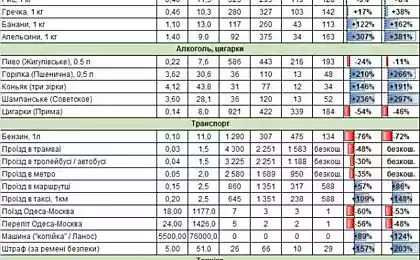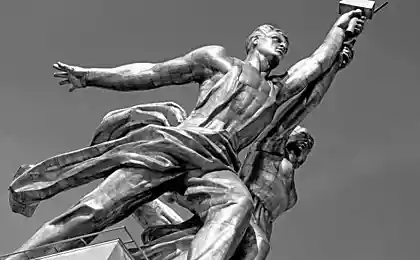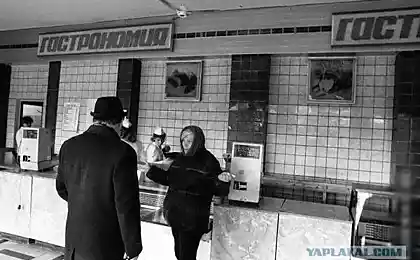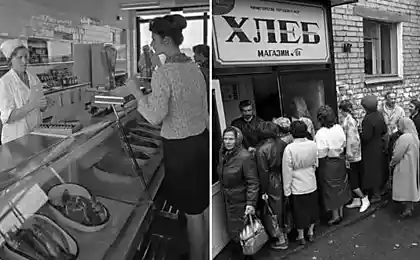219
What could be bought on the Soviet salary and how much did the average citizen receive?
Commodity-money relations have long been the main system of interaction between people. We are used to getting paid for our work and spending that money to buy the necessary things and services. Only the amount of this money and its denomination change. The current generation remembers the economic reforms of the Soviet Union. And what were they? USSR And what they could buy for an ordinary citizen. We will talk about this in our article from the editorial board. "Site"

Monetary reform in the USSR began almost immediately after the 1917 revolution. The royal money was seized, and new banknotes and coins came to replace them. Prices rose, money and its value changed. The last financial system of the USSR fell in the 60s and existed until the collapse of the Soviets. This money is remembered by the people of the once huge country. And what could be bought with the money of the USSR and what were the salaries of most citizens?

The average salary in the USSR in the 60-70s was 120 rubles. Such a salary for their work received engineers, teachers, doctors, factory workers. The average accounting did not include the income of the administration and leadership of the country and the party. The unspoken slogan in the country was to live modestly. Yes, in fact, to live on a "broad foot" could afford a few. Those who had connections or worked in commerce. Everyone else was content with a shortage and put aside money for many years to buy such desirable furniture or appliances.

The average salary was enough for a citizen to eat and buy necessities. The variety of products was small, and sometimes you had to stand in a huge queue to buy a product. It was also assumed that a person should develop culturally, so tickets to the cinema or theater cost little. Once a month you could afford to go to a movie or play. The cost of books was also small from 1 to 3 rubles and books were bought with great eagerness. True, there were banned authors and publications, there the cost of books increased significantly. But the USSR was one of the most read countries in the world.

In addition to the salary, the citizens of the country had a lot of “blubs”. Free lunches in dining rooms, a variety of sports sections for children, pioneer camps and recreation centers. All this was available on the condition that the person was a member of a trade union in the enterprise he worked for or an educational institution. This was a prerequisite and it was impossible to refuse this membership. Monthly from the salary calculated a certain percentage that went to the budget of the trade union organization. For this, an employee of the enterprise could safely count on an almost free ticket to a sanatorium or a children's camp for his child, gifts for holidays and even an initial payment for the purchase of furniture or equipment.

Thanks to a huge network of kolkhozes and food factories, food products cost very little. For example, one Soviet ruble could buy up to 10 kg of potatoes in the store and up to 20 kg in the bazaar. The main dish on the table of any Soviet family was bread. In general, bakery products in the USSR were very much - these are different buns, cakes, buns. And there were three types of bread: rye, Borodino and wheat. The latter was the most expensive at 24 cents. The weight of the loaf was approximately 1 kg. For three rubles in the store you could buy 1 kg of boiled sausage or 1 kg of hard cheese. The variety of these products was small, so most often ate sausage tea and cheese "Russian".

Instagram toys for children were also affordable and very high quality. Sometimes they were even inherited. For example, for 10 rubles you could buy a set of young technician and the child was happy to collect various devices and learn at the same time. It was also possible to buy a plane ticket for 10 rubles, so this type of transport was very popular to quickly get to the other side of the country. School uniform for a child cost an average of 20 rubles, but they bought it not for one year, but for growth.

As we have already said on the average salary, a Soviet person could easily live with necessities. In the USSR it was not customary to be unemployed and not active in public life. Therefore, everyone tried to make his contribution to the development of a great country. Do you remember what your first salary was and how it lived in the Soviet Union? Write about it in the comments under this article.

Monetary reform in the USSR began almost immediately after the 1917 revolution. The royal money was seized, and new banknotes and coins came to replace them. Prices rose, money and its value changed. The last financial system of the USSR fell in the 60s and existed until the collapse of the Soviets. This money is remembered by the people of the once huge country. And what could be bought with the money of the USSR and what were the salaries of most citizens?

The average salary in the USSR in the 60-70s was 120 rubles. Such a salary for their work received engineers, teachers, doctors, factory workers. The average accounting did not include the income of the administration and leadership of the country and the party. The unspoken slogan in the country was to live modestly. Yes, in fact, to live on a "broad foot" could afford a few. Those who had connections or worked in commerce. Everyone else was content with a shortage and put aside money for many years to buy such desirable furniture or appliances.

The average salary was enough for a citizen to eat and buy necessities. The variety of products was small, and sometimes you had to stand in a huge queue to buy a product. It was also assumed that a person should develop culturally, so tickets to the cinema or theater cost little. Once a month you could afford to go to a movie or play. The cost of books was also small from 1 to 3 rubles and books were bought with great eagerness. True, there were banned authors and publications, there the cost of books increased significantly. But the USSR was one of the most read countries in the world.

In addition to the salary, the citizens of the country had a lot of “blubs”. Free lunches in dining rooms, a variety of sports sections for children, pioneer camps and recreation centers. All this was available on the condition that the person was a member of a trade union in the enterprise he worked for or an educational institution. This was a prerequisite and it was impossible to refuse this membership. Monthly from the salary calculated a certain percentage that went to the budget of the trade union organization. For this, an employee of the enterprise could safely count on an almost free ticket to a sanatorium or a children's camp for his child, gifts for holidays and even an initial payment for the purchase of furniture or equipment.

Thanks to a huge network of kolkhozes and food factories, food products cost very little. For example, one Soviet ruble could buy up to 10 kg of potatoes in the store and up to 20 kg in the bazaar. The main dish on the table of any Soviet family was bread. In general, bakery products in the USSR were very much - these are different buns, cakes, buns. And there were three types of bread: rye, Borodino and wheat. The latter was the most expensive at 24 cents. The weight of the loaf was approximately 1 kg. For three rubles in the store you could buy 1 kg of boiled sausage or 1 kg of hard cheese. The variety of these products was small, so most often ate sausage tea and cheese "Russian".

Instagram toys for children were also affordable and very high quality. Sometimes they were even inherited. For example, for 10 rubles you could buy a set of young technician and the child was happy to collect various devices and learn at the same time. It was also possible to buy a plane ticket for 10 rubles, so this type of transport was very popular to quickly get to the other side of the country. School uniform for a child cost an average of 20 rubles, but they bought it not for one year, but for growth.

As we have already said on the average salary, a Soviet person could easily live with necessities. In the USSR it was not customary to be unemployed and not active in public life. Therefore, everyone tried to make his contribution to the development of a great country. Do you remember what your first salary was and how it lived in the Soviet Union? Write about it in the comments under this article.
A simple children’s problem with cherries, which will help test your attentiveness
Is it true that Elon Musk took a woman robot on a date?























